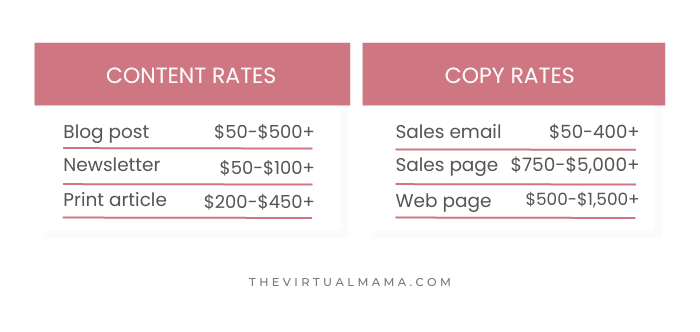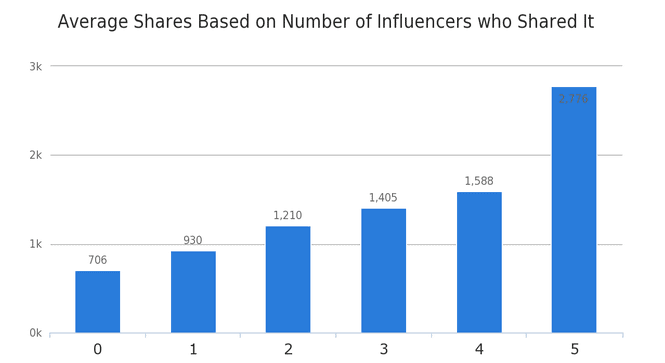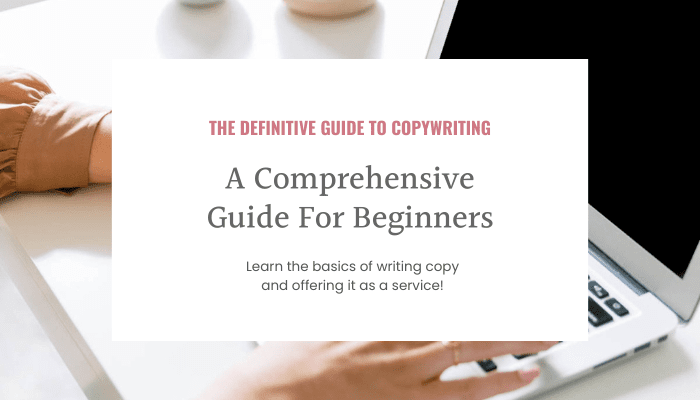Content Writing Vs Copywriting (10 Differences Every Writer Should Know)
Content writing vs copywriting: Learn the differences & decide which writing service you want to offer.
Table of Contents
Maybe you’ve heard about copywriting, but don’t really understand how to compare content writing vs copywriting.
Look no further—in this post today, I’m going to break down content writing vs copywriting and everything you need to know before choosing one or the other as your freelance niche.
You’ll learn:
- What a copywriter does
- How to transition into copywriting
- 10 differences between content writing vs. copywriting
- Real-life examples of content writing vs. copywriting
By the way, if you’re looking to offer both as a service to your clients, I’ll go over that later in this post.
Let’s dig in!
What Does A Copywriter Do?
A copywriter’s role is to write text for marketing material such as ads, emails, websites, brochures, or etc. that is clear and concise enough to compel readers to take a desired action.
Typically, the goal is to get that reader to either become a lead by opting into a form or to become a buyer by purchasing a product.
In simple terms, a copywriter writes words that sell.
Because copy helps brands sell with their words, copy can make or break sales for a business. That’s why good copywriters are in high demand!
Content Writing Vs. Copywriting: The Differences You Need To Know
Content writing and copywriting often get used interchangeably, but they’re entirely different.
You can usually tell them apart by their purpose.
In my free guide, The Definitive Guide To Copywriting, I explain the differences like this:
The goal of copy is to get a reader to take action (and it’s typically tied to buying a product or service).
Content, on the other hand, is meant to inform, entertain, or engage. It doesn’t necessarily involve selling anything.
Some examples of content are blog posts, social media captions, or employee bios to name a few.
Here are 10 other specific differences to help you get a better understanding.
#1 Copywriting is advertising.
Copywriting is essentially advertising. You’ll often hear it referred to as sales copy, conversion copy, or direct-response copy…but they all mean the same thing.
Copy can be found on promotional emails, webpages, billboards and even cereal boxes.
The next time you visit a website waving a shiny new product or service to try out, remember the words on that page are copy.
#2 Content writing attracts the leads so your copy can convert them.
When you think about a sales funnel (that’s the marketing journey a customer goes through before they make a purchase)…it usually begins with either an ad or piece of content.
You might be searching through Google for “best natural moisturizers” and see a blog post comparing five different ones.
Then you click on a product, and it will take you to a sales page.
See that? The content gave you the information you were looking for, but then it led you to sales copy that tried to persuade you to make a purchase.
A person can go from simply browsing to becoming a customer if your copy is compelling enough.
Elements of compelling copy include:
A clear call to action. It invites the user to take the “next step” in the customer journey.
A compelling headline. A headline is the unique title that piques the interest of the reader. It gets them to read the first sentence of your body copy, and hopefully read the rest of your ad or sales letter too.
A clear description of the offer. It gives detail about the features of the product or service being sold, the benefits of those features, and the problem the product or service solves.
#3 Content writing can be educational, informative, or entertaining.
Nobody wants to read something that doesn’t pique their interest in some way, and that’s why content should accomplish at least one if not all of the following:
Entertain. Great content tells a story or forms a connection with your emotions that makes you feel entertained.
Educate. It teaches a new idea, concept, or how to do something.
Inform. Content can be meant to simply give useful information (like a newspaper article).
(Hint: This blog post is an example of content writing that is meant to check all the boxes mentioned)
Now, when it comes to writing headlines for your content, there are some copywriting principles that can apply because it needs to have a “sticky” element to it.
Let me explain…
Imagine you’re searching Google for a video on “How to make a Charcuterie Board” and two different options appear.
Are you going to click on the video titled, “The Perfect Charcuterie Board” or “The 10 Most Beautiful Charcuterie Board Recipes?”
(I’ll take the “10 Most Beautiful Recipes!” for $500 Alex)

The takeaway here: copy is intended to persuade and/or sell, while content is meant to add some sort of informative value or be entertaining.
#4 Copywriting always has a call-to-action.
A call-to-action or CTA, is simply the next step you want your reader to take.
Sometimes it’ll be a button that leads the customer to a landing page or sales page with information they need to make a proper decision.
Some examples of a CTA include phrases like:
- Book Now
- Request a Free Quote
- Download your Free Guide
- Buy Now
- Subscribe
- Start Your Free Trial
- Click Here
- Join Now
- Claim Your Free Shipping
- Take Our Free Quiz
- Act Now
- Claim Your 10% Discount
- Add To Cart
#5 Copywriting incorporates psychology and principles of human behavior.
Copywriting uses psychological “triggers” to understand how people think, feel or behave.
A few psychological triggers copywriters use are:
- Pain Points (problems the customer may be experiencing)
- Social Proof (testimonies, interviews, case studies or reviews that build trust)
- Curiosity and Urgency
- Personal Connection
#6 Copywriting uses formulas.
A copywriting framework is a formula created to help you write more effective copy.
Who doesn’t love repeatable process?
Formulas are great to use when you’re having a hard time writing, and really want to make sure your copy is going to convert. (While it won’t “guarantee” anything, the formula will still help.)
As a copywriter, using copy formulas can help you
- Improve your writing skills
- Become faster at writing copy
- Ensure your incorporating persuasion principles that work
There are many different formulas, here are three formulas you can use to get started.
Attention-Interest-Desire-Action (AIDA)
This is a four-step process designed to get readers to take action.
Here’s the formula:
- Attention. Get the reader’s attention with a unique introduction.
- Interest. Keep the reader engaged by sharing interesting information.
- Desire. Emphasize the benefits of your product or service, and how it helps them get the transformation they crave.
- Action. Guide the reader to the next step. (This is the call-to-action.)
Before-After-Bridge (BAB)
This is a three-part structure used to direct a response from the reader.
The BAB formula works like this:
- Before. Share the problem that your product or service solves.
- After. Illustrate the benefits of using your product or service.
- Bridge. Show how your product or service can help your reader transition from before to after.
Problem-Agitate-Solution (PAS)
This is a three-part process that hooks the reader by leading with the reader’s pain point. (And if you don’t know already, it’s one of my favorite formulas).
The PAS framework works like this:
- Problem. Present the problem your product or service solves.
- Agitate. Agitate the reader’s pain point further.
- Solution. Offer your product or service as a solution to the problem.
#7 Content writing is (typically) SEO focused.
In case you’re new to the world of freelance writing, SEO stands for search engine optimization.
Some people specialize in SEO writing, and they know how to use specific “keywords” to help the content they’re writing rank higher on search engines like Google. This is valuable because ranking higher gets more traffic to the post.
Now, if you’re writing content that’s not for the web, obviously this doesn’t apply. But the majority of content we write these days does find it’s way online.
Copywriting isn’t typically focused on SEO (although some copywriters will optimize the web copy they write for SEO).
#8 Copy uses market research.
It’s a good practice to mention quotes, words and ideas used by another author when you’re writing content, but sales copy works differently.
Copywriting is heavily based on voice of customer research—meaning you’re conducting interviews, audits, and mining through research that’s openly available to create your own conclusion about how to market a product or service.
Your research will influence the way you speak about the product or service you’re selling, but it won’t be the subject of your copy like it would be in an article.
#9 Copywriters aren’t paid per word.
The way content writers and copywriters are paid for projects is entirely different.
You might hear about writers getting paid on a per-word basis for blog posts or other types of articles. Copywriting doesn’t work like that.
Copy isn’t valued by how long it is, but rather the value of the copy.
That’s why a well established copywriter can earn $200-$500 for a sales email, while another writer might earn that for a long-form blog post that’s more than triple the length.
Here are some sample rates for content writing vs copywriting to give you an idea:

Rates will vary depending on your skill level, experience, and ability to get results for your clients.
To learn more about how to set rates for copywriting services, check out The Definitive Guide To Copywriting.
#10 Copywriting gets to the point.
Here’s what I mean…
If you’re writing a non-fiction book, blog article, newspaper editorial or etc., you might use a lot of descriptive, colorful language that builds up the story.
When you write copy however, you want to cut out any fluff. Your copy has to be clear, concise, and to the point.
This doesn’t mean copy has to be short, it just means there isn’t room for words that aren’t serving a purpose. Every word in your copy needs to count and add value.
Examples Of Content Writing Vs Copywriting
As mentioned earlier, the goal of copy is to get a reader to take an action, while content is designed to inform, entertain, or engage.
Check out the examples below, and see if you can tell the difference.
Example A

(Source: Gemma Bonham Carter)
Example A is clearly a form of copy because it’s persuading readers to download the free guide.
Example B

(Source: OptinMonster)
This example is a headline for an article, which is considered content as well. It’s giving information that’s valuable to the reader, but it’s not persuading them to do anything.
Example C

(Source: Buzzsumo)
So what do ya’ think about this one?
Kind of a trick question here. This graph could technically be used for sales copy or content. (Using data to back up your copy is powerful!)
How To Transition From Content Writing To Copywriting
We’ve been talking about all the differences to know when comparing content writing vs copywriting…
But you know what? Sometimes, they can cross over or work together. I think this is what makes writing more fun, exciting and creative 🙂
If you’ve been comparing what it’s like to niche into content writing vs copywriting and you’re ready to pick a side, ask yourself a few questions first…
Do you prefer writing that’s informative, educational and engaging?
Or do you enjoy crafting persuasive arguments with copy?
If you decide you want to make the transition, here are a few ways to get started.
Learn Basic Copywriting Principles
The most important thing you need to do before transitioning to copywriting, is learning how to write copy.
I have a free copywriting class here that will help you get started.

Here are a few extra tips that will help too:
Know your audience. Identity their problems and learn to think like them.
Write compelling headlines. Don’t waste anytime—make sure you hook your reader right away.
Have a clear call-to-action. Remember, the CTA is the next step that you want the reader to take after reading your copy.
Improve your skills. Invest in resources that’ll help you become an in-demand copywriter. (You can start with this free class).
Become a resource. Most people don’t know how to write copy, but you can become a go-to resource for people in your network. Start talking about what you do with others, and share your expertise to help other entrepreneurs in their business.
Create a process for your projects. This helps build trust with potential clients.
Upsell Your Content Writing Clients
Upselling is a great way to expand your business. If you’re already serving clients, why not see if they need copy too?
There’s many services you can offer as a copywriter, but here are a few examples to get you started:
Web Copy
This includes copy for landing pages, sales pages, or entire websites.
Email Copy
Email is one of my favorite kinds of copy to write. It can include full sequences or weekly newsletters.
It’s a great service for copywriters to offer because you can create retainer packages for newsletters.
Ads
Ad copy can include social media ads, Google ads, or print ads for magazines, billboards, and etc.
Announce Your Transition
This might sound obvious, but you’d be surprised at how many people don’t actually announce they’re new transition into copywriting.
Once you decide to offer copywriting, you want to let everyone in your network know about it. That includes past colleagues, friends, family, and even your followers on social media.
When my husband and I launched our agency, I sent a personalized email to everyone I knew!
The email went something like this…
- I opened the email by letting them know why they’re hearing from me (and that’s because I appreciated our working relationship).
- I segued into what I was working on, how our agency helps other businesses, and shared a free resource (our lead magnet).
- I let them know I was open to referrals.
^^ I wrote the email like an update instead of a pitch, and it was well received.
Simply letting your network know about your services is the easiest and fastest way to get potential leads. You never know who in your network actually might need help with copy for their business (and if they don’t, they might know someone who does).
Also…this is a great time to ask people if they’re interested in getting more updates from you (if so, you can add them to your email list).
How To Incorporate Content Writing Into Your Copywriting Business
Copywriting is a lucrative business, but that doesn’t mean that content writing isn’t important.
We still need content for our “marketing ecosystem” to function. If you enjoy content writing, and want to offer a hybrid of both services, here are some ways you can do that.
Create Retainer Packages For Content Services
As a copywriter, sometimes you’re working on a number of paid projects in the hopes of creating a steady cash flow.
One week you can be in high-demand and the next week can be a little slower. (That’s how freelance life can be sometimes.)
So you might be wondering, how do you avoid these gaps as much as possible?
One approach to help you reduce the “feast or famine” cycle is to offer your copywriting clients ongoing services for content.
If they like the copy you wrote for their email sequence, website, or ad…why not offer to write weekly blog posts or newsletters too?
This not only helps your client, but also will bring in steady cash.
(BTW, this kind of “ongoing work” is called a retainer. It means you get a flat fee each month for the deliverables you give to your client.)
Aside from blog posts or newsletters, you can offer:
- Podcast show notes
- Social media captions
- Scripts (for YouTube videos or podcasts)
You can also ask your client directly if they need any other types of writing for their business. They might have a unique need that I didn’t cover, and that’s a great opportunity to pitch a customized package.
Use Content To Attract Leads To Your Own Business
Content writing isn’t only for clients…you can implement it into your own business to attract more leads.
Here are a few examples of how you can do that:
Create a lead magnet. A lead magnet is a free resources that you offer readers in exchange for their email address. You want to create something useful that your potential clients would find helpful. This can be a checklist, eBook, or guide.
Just make sure it’s something of real value and not just generic “fluffy” content. The goal is to show them the value of working with you.
Start a blog. If you thought it was too late to start a blog, you’re wrong. Blogging is a great way to get SEO traffic, but also to share your expertise and position yourself as a thought leader in your niche.
When I browse a person’s website, one of the first place I go to is the blog section. I like to see what helpful content they have, and on some occasions, it has led me to want to work with the person.
Post thoughtful content on social media. The key here is “thoughtful.” You don’t want to regurgitate what everyone else is saying, so find a new or unique way to share information about what you do.
I recommend starting with just one social media platform and being consistent with it. If you try too many channels at once, it could get overwhelming.
If you’re not sure which platform to start on, go where you’ll find the types of businesses you want to work with. I find LinkedIn is generally a great start.
Conclusion On Content Writing Vs Copywriting
If you’ve been scratching your head trying to compare content writing vs copywriting, I hope this post helped answer your questions!
Let me know in the comments, do you see yourself as more of a content writer or copywriter?
Looking for more?
How To Successfully Transition Into Copywriting (Step-By-Step Plan)
How To Write A Copywriting Proposal (Free Template)
How To Become An In-demand Copywriter







I absolutely love the detail in this post describing those differences. For me, I LOVE content writing, but I also LOVE copywriting! I’m also learning that if it’s a slow time for getting copywriting gigs, having content writing gigs still help to bring money in
Thanks for sharing that Claire! I completely know what you mean about enjoying both. I love the flexibility of incorporating content writing in my own business. I think offering both is a great option as well!